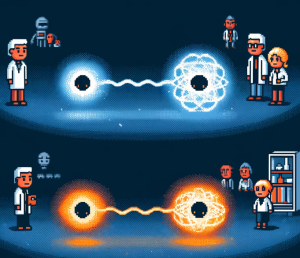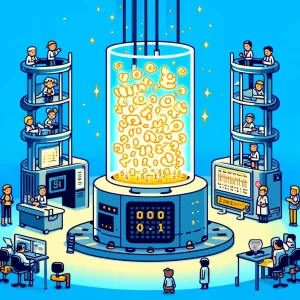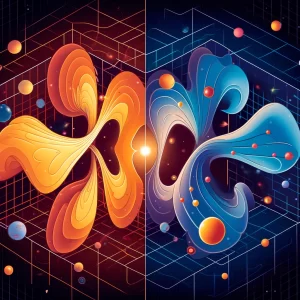
Quantum Mysteries and Wavefunction Matching
Imagine trying to solve a jigsaw puzzle with pieces that constantly change shape. This is akin to the challenge scientists face when trying to understand quantum many-body systems—complex arrangements of particles interacting in unpredictable ways. Recently, a groundbreaking method called wavefunction matching has made significant strides in simplifying these puzzles, offering hope for more accurate calculations in nuclear physics and beyond.
The Puzzle of Quantum Many-Body Systems
Quantum many-body systems are notoriously difficult to study due to the complex interactions between particles. These systems appear in various fields, from quantum chemistry and atomic physics to nuclear physics. Traditional methods often fall short when dealing with the intricate dance of particles, leading to inaccuracies and computational roadblocks.
One of the most promising approaches to tackle these issues is through quantum Monte Carlo simulations. These simulations use stochastic processes to model quantum systems. However, a significant challenge remains: the “sign problem,” where positive and negative contributions cancel out, making calculations impractical. This is where wavefunction matching steps in.
Wavefunction Matching: A Revolutionary Approach
Wavefunction matching transforms the interactions between particles to create a new, more manageable problem. This transformation allows the system’s wavefunctions to match those of a simpler, easily computable interaction. By doing so, it sidesteps the sign problem and enables accurate calculations for systems that were previously out of reach.
The process involves creating a new Hamiltonian—a mathematical description of the system’s total energy—that closely mimics the original but is easier to work with. This new Hamiltonian, called H′H’H′, is designed such that its wavefunctions are proportional to those of a simple Hamiltonian HSH_SHS for short distances between particles. This proportionality allows for rapid convergence in calculations, making previously impossible computations feasible.
Applying Wavefunction Matching in Nuclear Physics
The researchers applied wavefunction matching to lattice Monte Carlo simulations of various nuclear systems, including light nuclei, medium-mass nuclei, neutron matter, and nuclear matter. Using high-fidelity chiral effective field theory interactions, they achieved remarkable agreement with empirical data.
For instance, in calculating the binding energy of the deuteron (a nucleus of one proton and one neutron), wavefunction matching yielded a result of 2.02 MeV, very close to the true value of 2.21 MeV and the experimental value of 2.22 MeV. This accuracy showcases the method’s potential to revolutionize nuclear physics calculations.
Implications for Nuclear Binding Energies and Charge Radii
Wavefunction matching also proved its worth in calculating the binding energies of 3H (tritium) and 4He (helium-4). The method aligned well with the Tjon band, a universal correlation between the binding energies of these nuclei. This alignment suggests that the approach can reliably predict nuclear properties, reducing errors to about 0.1 MeV per nucleon.
Additionally, the method showed promising results for calculating the charge radii of nuclei. Charge radius is a measure of the size of an atomic nucleus, and accurate predictions of this property are crucial for understanding nuclear structure. Wavefunction matching achieved an impressive root-mean-square deviation of about 0.03 femtometers, indicating excellent agreement with experimental data.
A Broader Impact on Quantum Many-Body Systems
While the focus of this research was on nuclear physics, the implications of wavefunction matching extend far beyond. This method can be applied to any quantum many-body system, including those in quantum computing. By simplifying complex interactions, wavefunction matching could reduce the number of quantum gates required in quantum algorithms, making quantum computing more efficient and practical.
Conclusion
Wavefunction matching represents a significant leap forward in our ability to understand and predict the behavior of quantum many-body systems. By transforming complex interactions into more manageable forms, this method opens the door to more accurate and practical calculations in nuclear physics and beyond. As researchers continue to refine and expand its applications, wavefunction matching could become a cornerstone of quantum research, solving puzzles that once seemed unsolvable.
Explore and Learn with Science:
Dive into groundbreaking research and inspiring stories with ‘This Week in Science’! Perfect for teachers and science enthusiasts, our free weekly newsletter expands your horizons in teaching and learning. Join us today and reshape your engagement with science.
About the Author
Dr. Jonathan P. Scaccia, PhD, is a clinical-community psychologist with expertise in public health science and practice. He has led evaluation and research initiatives focusing on health equity, vaccine distribution, and organizational readiness. Dr. Scaccia has contributed to federal suicide prevention programs and vaccine equity strategies. Recognized with awards for his impactful work, he is a leading voice in advancing public health practice.



